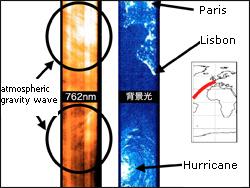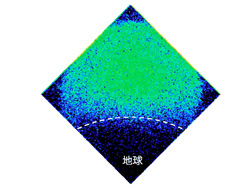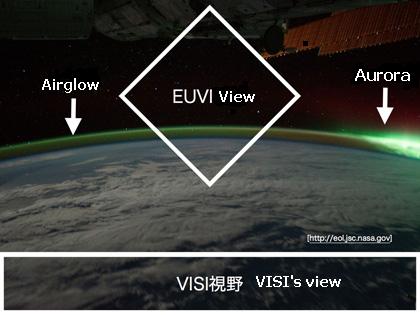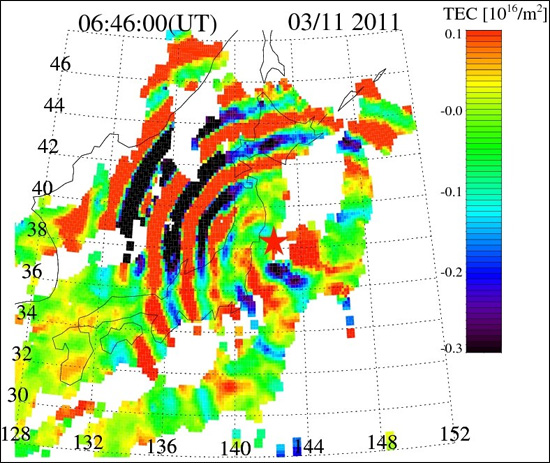Ionosphere, Mesosphere, upper Atmosphere, and Plasmasphere mapping (IMAP) mission obtained its first observation data
Last Updated:
January 28, 2013
Imagers for Ionosphere, Mesosphere, upper Atmosphere, and Plasmasphere mapping (ISS-IMAP) mission installed to the Exposed Facility (EF) of Kibo on the International Space Station (ISS) obtained its first observation data.
The ISS-IMAP mission intends to seek the causes of climate oscillation of the Earth and the reception difficulty and deterioration of satellite communication and the global positioning system (GPS) navigation devices. The mission uses two imagers, the visible-light and infrared spectrum imager (VISI) and extra ultraviolet imager (EUVI) to observe airglow and plasma resonant light scattering in the Earth's upper atmosphere.
As a joint research by JAXA, Kyoto University, Tohoku University, the University of Tokyo, Nagoya University, Kyushu University, National Institute of Information and Communications Technology (NICT), National Institute of Polar Research, and so on, the hardware was launched to the ISS on July 21, 2012, aboard the H-II Transfer Vehicle (HTV) KOUNOTORI3 and installed to the Exposed Facility (EF) of Kibo. Later, following the initial observation in August, the regular observation was started on October 15. The following initial observation data was obtained on September 25-26.
Airglow obtained by VISI (September 25, 2012)

[Fig. 1] Airglow at 762nm of wavelength (11:20 am JST, September 25, 2012)
This observation of airglow at 762nm of wavelength by VISI succeeded in capturing the waves of upper atmosphere at an altitude of 95 km, of which were seen at dozens of kilometers of horizontal wavelength (white diagonal lines in orange are waves in the picture.) These waves are called atmospheric gravity waves.
Observation from space realizes the observation of areas which previously has been impossible, and the observation of entire global oscillation becomes possible.
Ionic resonant light scattering obtained by EUVI (September 26, 2012)

[Fig. 2] Resonant light scattering of He+ was obtained by EUVI. Observed over near New Zealand (4:00 pm JST, September 26, 2012)
Light of helium ions in ionosphere was observed at an altitude of 1,000 km or over. Though the light is very weak, we confirmed that the ultrasensitive shooting was working.
Each edge of the image appears dark due to the imager's sensitivity characteristics.
【Remarks from PI, Akinori Saito, Associate professor of Kyoto University】
VISI and EUVI demonstrated ultrasensitive imaging as we designed. We confirm that we are able to observe the "invisible airglow." For the next two years we will observe the wide fluctuations of the upper atmosphere and ionosphere of the entire globe.
We expect that the mission will enable us to investigate the causes of climate oscillation of the whole Earth and the reception difficulty and deterioration of satellite communication and the global GPS navigation devices.
- ISS-IMAP website
Supplemental reading
About ISS-IMAP
- IMAP's two imagers and their fields of view
ISS-IMAP mission uses two equipments. VISI captures airglow through visible light and near-infrared light while EUVI captures plasma resonant light scattering through ultraviolet rays.
VISI is a slit-scan camera and installed to the bottom facing the Earth side. Scanning the Earth surface like a scanner, it captures the airglow generated by atoms and molecules of O, OH, and O2. EUVI is installed to the backward to capture the rim of the Earth and the space above the rim to take the images of lights that are generated by He+ and O+ scatter the ultraviolet rays from the Sun.
Figure 3 shows the fields of VISI and EUVI. Though normal cameras just capture aurora and clouds near the ground, ISS-IMAP's ultrasensitive imagers can capture airglow at outermost part of the atmosphere and over clouds.

[Fig. 3] Capture fields of VISI and EUVI are shown on the photo
taken by a normal digital camera (Credit: Kyoto Univ./JAXA/NASA)
- Observation target
ISS-IMAP targets to take the phenomena of airglow and plasma resonant light scattering in the rim of Earth's atmosphere and space (upper atmosphere: altitude range 85 km - 20,000 km). Aurora is well known as the atmospheric light generated at this area. ISS-IMAP captures not only aurora, but the airglow and plasma resonant light scattering.
From space, ISS-IMAP is able to perform the observation of whole Earth without the interruption of clouds taking advantage of the movement of the ISS.
- Phenomena to be observed
Atmospheric waves (Atmospheric gravity waves)
When airglow is photographed, a natural phenomenon called the atmospheric waves (atmospheric gravity waves) occur that upper atmosphere waves like the sea. Atmospheric waves take an important role for energy transportation in the earth atmosphere and affect climate oscillation. After the Tohoku Region Pacific Coast Earthquake on March 11, 2011, atmospheric waves occurred by the rise of sea level and affected the upper atmosphere. Since ISS-IMAP can observe the outbreak and the oscillation of atmosphere waves, effects of atmospheric waves on the upper atmosphere can be investigated.
Disorder of ionosphere (plasma disturbance)
When plasma light scattering is taken, waves in ionosphere are observed. When there are waves or disorder generated in ionosphere, they cause the disorder on satellite electric waves and results in a reception disorder or deterioration of satellite communication and the GPS navigation devices. Conducting precise observation and monitoring such disorders in ionosphere will lead to the development of a method to prevent a reception disorder of satellite communication and the GPS navigation devices.

[Fig. 4] Plasma in ionosphere at an altitude of 300 km affected by the atmospheric gravity waves due to the Tohoku Region Pacific Coast Earthquake on March 11, 2011. Central star sign is showing earthquake center. Ghost like Japanese island are visible because of multi GPS satellite data are processed all together. This obtained only a partial data. If observed from space, an entire picture of certain points on Earth can be grasped. (Image courtesy of Kyoto University)
*All times are Japan Standard Time (JST)




